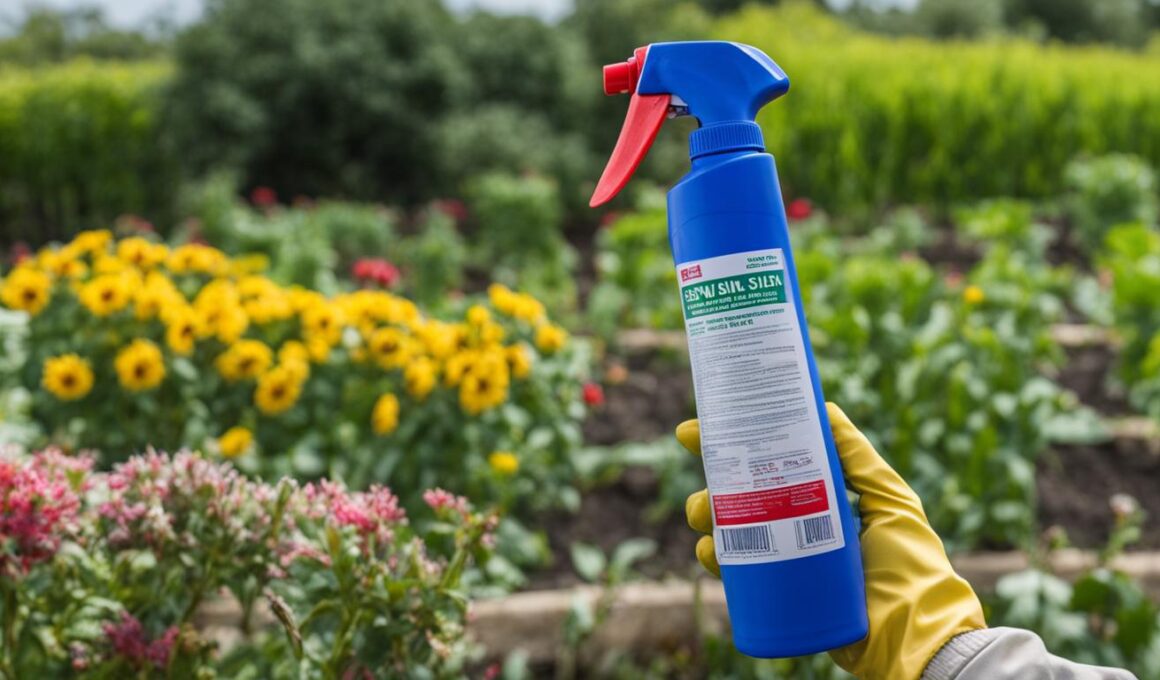Sevin insecticide, also known as Sevin SL (Sevin Soluble Liquid concentrate), is a popular product used for controlling various insects in plants, trees, soil, and lawns. It contains the active ingredient carbaryl, which belongs to a class of insecticides called carbamates.
When used according to instructions, Sevin SL is considered safe for use in residential settings. Although carbaryl has shown effects on the reproductive, developmental, and nervous systems in animal testing, these effects are not expected at the low levels of exposure from Sevin SL. It is important to understand the impact of Sevin insecticide on your safety and take necessary safety precautions in your home environment.
Post Summary
- Sevin insecticide is a widely used product for controlling insects in residential settings.
- Carbaryl, the active ingredient in Sevin, has shown effects on animal reproductive, developmental, and nervous systems.
- When used according to instructions, Sevin is considered safe for use in residential environments.
- It is important to take safety precautions and follow label instructions when using Sevin insecticide.
- Seek medical advice in case of any exposure to Sevin SL.
Understanding Carbaryl and its Effects
Carbaryl, the active ingredient in Sevin insecticide, is a carbamate insecticide that disrupts the nervous system of insects. It can be taken up by insects via direct contact or ingestion and slows the breakdown of a key chemical in their nervous system.
According to animal testing, carbaryl has shown effects on the reproductive, developmental, and nervous systems. However, these effects are not expected at the low levels of exposure from Sevin SL when used according to instructions.
Sevin SL also contains inert ingredients that may cause slight skin or eye irritation at higher concentrations. However, when used according to label instructions, the exposure to these ingredients is very low.
Carbaryl disrupts the nervous system of insects, but its effects are not expected at the low levels of exposure from Sevin SL when used correctly.
Carbaryl’s Insecticidal Properties
| Property | Effect |
|---|---|
| Disruption of Nervous System | Insects’ nervous system slows down due to carbaryl’s impact |
| Reproductive Effects | Seen in animal testing but not expected at low exposure levels from Sevin SL |
| Developmental Effects | Not expected at low exposure levels from Sevin SL |
| Skin and Eye Irritation | Possible at higher concentrations of inert ingredients |
| Low Exposure | When used according to label instructions, exposure to inert ingredients is minimal |
It is important to note that while Sevin insecticide is safe when used correctly, it is always recommended to follow label instructions, take necessary precautions during application and after, and seek medical advice in case of any exposure. By understanding the properties and effects of carbaryl, you can make informed decisions about its use and ensure the safety of yourself, your family, and the environment.
Precautions for Using Sevin Insecticide
When using Sevin insecticide, it is important to take certain precautions to ensure safe application and minimize exposure. By following these guidelines, you can use Sevin SL effectively while taking care of your own well-being.
Application Precautions
- Stay indoors during treatment: To reduce the risk of inhalation exposure, it is recommended to stay indoors while applying Sevin insecticide. Close all windows and doors, and turn off ventilation systems that receive outside air.
- Avoid direct contact: It is important to prevent skin contact with Sevin SL during application. Wear protective clothing, including gloves, long sleeves, and pants.
- Keep children and pets away: During treatment, ensure that children and pets are kept away from the treated areas to minimize the risk of exposure.
Post-Application Precautions
- Wait until material has dried: Before entering areas that have been treated with Sevin insecticide, it is recommended to wait until the material has dried. This reduces the risk of skin contact and ingestion.
- Avoid yard work and outdoor activities: Immediately after application, it is advised to avoid performing yard work or allowing children to play near the treated areas. Waiting at least 24 hours before resuming these activities is suggested as an extra precaution.
- Seek medical advice if exposed: In case of ingestion, skin contact, or eye contact with Sevin SL, it is important to seek medical advice promptly. Contact your healthcare provider or local poison control center for guidance.
By following these precautions, you can ensure the safe and effective use of Sevin insecticide in your home environment. Remember to always read and follow the label instructions provided with the product. Taking the necessary steps to protect yourself, your family, and the environment will help you maintain a pest-free environment while minimizing potential risks.
Sevin Insecticide and Food Safety
Fruits and vegetables grown in residential settings can be safely harvested as early as 7 days after the application of Sevin SL insecticide. However, it is important to take additional precautions to ensure food safety. After harvesting, thoroughly wash both your hands and the fruits and vegetables before consumption. This will help remove any residues of the insecticide, reducing the potential for exposure.
To ensure proper washing, follow these steps:
- Start by rinsing the produce under running water to remove any visible dirt or debris.
- Use a scrub brush or your hands to gently rub the surface of the fruits and vegetables, ensuring thorough cleaning.
- Pay extra attention to leafy greens and other produce with crevices or uneven surfaces.
- Rinse the produce again under running water to remove any remaining dirt or cleaning solution.
- Pat dry the fruits and vegetables with a clean towel or let them air dry before storage or consumption.
By following these simple steps, you can enjoy the bounty of your homegrown fruits and vegetables while minimizing any potential exposure to Sevin insecticide residues.
“Thoroughly washing fruits and vegetables after harvesting is an essential step in ensuring food safety. It helps remove any pesticide residues and dirt, reducing the risk of exposure to harmful substances. Taking proper precautions and following recommended washing practices can go a long way in safeguarding your health and the well-being of your loved ones.” – Dr. Lisa Gardner, Food Safety Expert
| Produce | Harvesting Time After Sevin SL Application |
|---|---|
| Tomatoes | 7 days |
| Peppers | 7 days |
| Squash | 7 days |
| Apples | 7 days |
| Strawberries | 7 days |
Table: Harvesting time for selected fruits and vegetables after the application of Sevin SL insecticide.
Pesticide Products Containing Carbaryl
| Product Name | Application | Target Pests |
|---|---|---|
| Product 1 | Agricultural Crops | Pest 1, Pest 2, Pest 3 |
| Product 2 | Home Gardens | Pest 4, Pest 5, Pest 6 |
| Product 3 | Lawns | Pest 7, Pest 8, Pest 9 |
| Product 4 | Ornamental Plants | Pest 10, Pest 11, Pest 12 |
Health Effects of Carbaryl in the Environment
Carbaryl, the active ingredient in Sevin insecticide, poses health risks to humans and various environmental organisms. In terms of human toxicity, carbaryl is toxic through ingestion, skin contact, eye contact, and inhalation. It is classified as “likely to cause cancer” based on studies conducted on mice by the Environmental Protection Agency (EPA). However, the estimated lifetime cancer risk from consuming foods with carbaryl residues is considered low.
Carbaryl is highly toxic to bees, aquatic invertebrates, and shellfish, making it essential to take precautions to protect these organisms. It is also moderately to highly toxic to fish and earthworms, while being practically non-toxic to birds and mammals. These varying levels of toxicity highlight the need for responsible use of carbaryl-based products to minimize their impact on the environment.
Carbaryl is toxic to humans through ingestion, skin contact, eye contact, and inhalation. It is also very toxic to bees, aquatic invertebrates, and shellfish. While moderately to highly toxic to fish and earthworms, it is practically non-toxic to birds and mammals.
To better understand the potential impact of carbaryl, it is important to consider its breakdown and movement in the environment. Carbaryl breaks down relatively quickly in soil and water due to microbial activity and sunlight. However, in deep soil with limited oxygen, the breakdown process is slower. When applied to leaf surfaces, carbaryl is minimally absorbed but can be taken up by roots and transported to areas of active growth. These dynamics contribute to the potential exposure of various organisms in different environmental compartments.
Overall, the health effects of carbaryl underscore the importance of responsible usage and adherence to safety precautions. By following label instructions, minimizing direct exposure, and taking steps to protect vulnerable organisms, it is possible to manage insect pests effectively while minimizing risks to human health and the environment.
Long-term Effects of Carbaryl Exposure
Long-term exposure to carbaryl can have various non-cancer effects on both humans and animals. In animal studies, low to moderate daily doses of carbaryl have shown developmental effects such as decreased weight and incomplete bone formation in developing rats. After birth, fewer young rats survived than normal, and changes in brain development were observed. Similar effects, such as lower body weights in young rabbits, were also observed. However, no reproductive effects were observed in test animals, and carbaryl is not likely to act as an endocrine disruptor.
In addition to developmental effects, long-term exposure to carbaryl has been shown to affect different organ systems. Studies with rats have demonstrated effects on the liver, kidneys, thyroid, and certain muscles and nerves. These findings highlight the importance of minimizing exposure to carbaryl to reduce the potential long-term health effects.
Long-term Effects of Carbaryl Exposure in Humans
While animal studies provide insights into the potential long-term effects of carbaryl exposure, it’s essential to consider the relevance to human health. Human studies are limited, but high daily doses of carbaryl for extended periods have shown various health effects, including blood vessel tumors and decreased muscle tone and seizures. However, it’s important to note that these effects were observed at much higher doses than what is typically encountered in residential settings.
It’s also worth mentioning that carbaryl has been classified as “likely to cause cancer” by the Environmental Protection Agency (EPA) based on studies conducted on mice. However, the estimated lifetime cancer risk from eating foods with carbaryl residues is considered to be low. This assessment takes into account the levels of carbaryl residues found in food and evaluates the potential risk to human health.
In summary, long-term exposure to carbaryl can have developmental effects in animals, but the relevance to humans is still being studied. Ongoing research is crucial to further understand the potential long-term effects of carbaryl exposure and ensure the safety of its use in residential settings.
Sensitivity to Carbaryl in Children
Children may have increased sensitivity to pesticides like carbaryl compared to adults. In a study conducted with rats, young rats were found to be 80% more sensitive to carbaryl’s effects on the brain compared to adult rats. This suggests that children may be more susceptible to the potential health effects of carbaryl exposure.
Children’s behavior, such as spending more time near the ground and frequently putting their hands in their mouths, can increase their risk of exposure to carbaryl and other pesticides. Hand-to-mouth contact is a common way for children to accidentally ingest small amounts of pesticides that may be present on surfaces or objects. This contact can happen while playing outdoors or even indoors if there is residue from pesticide applications.
It is important for parents and caregivers to take precautions to minimize children’s exposure to carbaryl and other pesticides. This can include keeping children away from treated areas until the material has dried, ensuring proper handwashing after outdoor activities, and regularly cleaning and washing fruits and vegetables from residential gardens to remove any pesticide residues. By being aware of children’s behaviors and taking appropriate measures, the potential risks associated with carbaryl exposure can be minimized.
Comparison of Exposure Risks in Children and Adults
| Exposure Route | Potential Risk in Children | Potential Risk in Adults |
|---|---|---|
| Ingestion | Increased risk due to hand-to-mouth contact and behaviors | Similar risk as children if exposed through hand-to-mouth contact |
| Skin Contact | Similar risk as adults if exposed through direct contact | Similar risk as children if exposed through direct contact |
| Inhalation | Similar risk as adults if exposed to airborne particles | Similar risk as children if exposed to airborne particles |
Environmental Impact of Carbaryl
Carbaryl, the active ingredient in Sevin insecticide, has various environmental impacts due to its breakdown in different mediums. When applied to leaf surfaces, carbaryl is minimally absorbed but taken up by the roots and transported to areas of active growth in plants. In soil, carbaryl breaks down relatively quickly, primarily through the action of microbes and sunlight. However, in deep soil where oxygen is limited, the breakdown of carbaryl is slower. This breakdown process ensures that carbaryl residues in soil are reduced over time, minimizing its persistence in the environment.
When carbaryl is introduced into water, it also undergoes breakdown processes. Microbial activity and exposure to sunlight help to degrade carbaryl, decreasing its concentration in water. These breakdown mechanisms contribute to reducing the potential impact of carbaryl on aquatic organisms, although it is still considered to be moderately to highly toxic to fish and aquatic invertebrates.
“Carbaryl breaks down relatively quickly in soil and water due to the action of microbes and sunlight.”
Carbaryl has a low potential to evaporate into the air when applied as an insecticide. Instead, it remains on leaf surfaces or is taken up by plants. This reduces the risk of airborne exposure to carbaryl for humans and other organisms. However, it is important to follow label instructions and avoid applying carbaryl in areas with high wind conditions to minimize potential drift.
Overall, carbaryl demonstrates varying levels of toxicity to different organisms. It is practically non-toxic to birds and mammals, moderately to highly toxic to fish and aquatic invertebrates, and highly toxic to earthworms and honey bees. Understanding these environmental impacts can help guide responsible use and minimize the potential risks associated with carbaryl-based insecticides like Sevin.
Environmental Breakdown of Carbaryl
| Medium | Breakdown Mechanism | Impact on Carbaryl Residues | Environmental Toxicity |
|---|---|---|---|
| Leaf Surfaces | Minimally absorbed, taken up by roots | Reduced over time | Low potential for airborne exposure |
| Soil | Microbial activity and sunlight | Relatively quick breakdown | Moderate to high toxicity to fish and earthworms |
| Water | Microbial activity and sunlight | Decreased concentration | Moderate to high toxicity to fish and aquatic invertebrates |
| Air | Low tendency to evaporate | Remains on leaf surfaces or taken up by plants | Practically non-toxic to birds and mammals |
Conclusion
When it comes to Sevin insecticide, safety is paramount. By following proper precautions and safety guidelines, you can confidently use Sevin to control a wide variety of insects in residential settings. It is important to understand that while carbaryl, the active ingredient in Sevin, has shown effects on the reproductive, developmental, and nervous systems in animal testing, these effects are not expected at the low levels of exposure when Sevin SL is used according to instructions.
To ensure your safety and minimize any potential health effects, it is crucial to carefully read and follow the label instructions. Take necessary precautions during application and after, such as staying indoors during treatment, waiting for the material to dry before entering treated areas, and wearing gloves and protective clothing if entering the treated area before it has dried. In case of any exposure, such as ingestion, skin contact, or eye contact with Sevin SL, seeking medical advice is important.
By understanding the safety measures and risks associated with Sevin insecticide, you can effectively manage insect pests while protecting your health and the environment. Remember, proper usage and adherence to safety guidelines are key to ensuring the safe and responsible use of Sevin insecticide in your home environment.
Is Sevin Insecticide Safe to Use in Gardens When PVC is Present?
When it comes to pvc safety in gardening, it’s important to consider the potential risks of using Sevin insecticide. While Sevin is generally safe for use in gardens, it’s best to avoid spraying it directly on PVC materials, as it can cause damage over time. Be mindful of your garden’s materials when using any insecticide.
FAQ
Is Sevin insecticide safe to use?
When used according to instructions and safety guidelines, Sevin insecticide is considered safe for use in residential settings.
What is carbaryl and what are its effects?
Carbaryl is the active ingredient in Sevin insecticide. It disrupts the nervous system of insects. While it has shown effects on the reproductive, developmental, and nervous systems in animal testing, these effects are not expected at the low levels of exposure from Sevin SL.
What precautions should I take when using Sevin insecticide?
During treatment, stay indoors, close all windows and doors, and turn off ventilation systems that receive outside air. After treatment, avoid performing yard work or allowing children to play near treated areas until the material has dried. If necessary to enter the treated area, wear gloves and protective clothing. In case of ingestion, skin contact, or eye contact, seek medical advice.
Can I harvest fruits and vegetables after using Sevin insecticide?
Yes, fruits and vegetables grown in residential settings can be harvested as early as 7 days after the application of Sevin SL. Thoroughly wash hands as well as the fruits and vegetables after harvesting to remove any residues.
Are there other products containing carbaryl?
Yes, there are over 190 registered pesticide products that contain carbaryl, including sprays, dusts, granules, and water-soluble packages. These products can be used on various crops, home gardens, lawns, and plants.
What are the health effects of carbaryl in the environment?
Carbaryl is toxic to humans through ingestion, skin contact, eye contact, and inhalation. It is also very toxic to bees, aquatic invertebrates, and shellfish. It is moderately to highly toxic to fish and earthworms.
What are the long-term effects of carbaryl exposure?
In animal studies, long-term exposure to carbaryl has shown various health effects on the liver, kidneys, thyroid, certain muscles, nerves, and brain development. However, it is not likely to act as an endocrine disruptor, and no reproductive effects were observed in test animals.
Are children more sensitive to carbaryl?
Yes, children may be more sensitive to pesticides like carbaryl compared to adults. Their behavior, such as spending more time near the ground and putting their hands in their mouths, may increase their risk of exposure.
How does carbaryl break down in the environment?
Carbaryl breaks down relatively quickly in soil and water due to the action of microbes and sunlight. It has a low potential to evaporate into the air and is minimally absorbed when applied to leaf surfaces but taken up by the roots and moves to areas of active growth.
What is the conclusion regarding Sevin insecticide safety?
Sevin insecticide can be safely used to control insects in residential settings when proper precautions and safety guidelines are followed. It is important to follow label instructions, take necessary precautions during application and after, and seek medical advice in case of any exposure.











